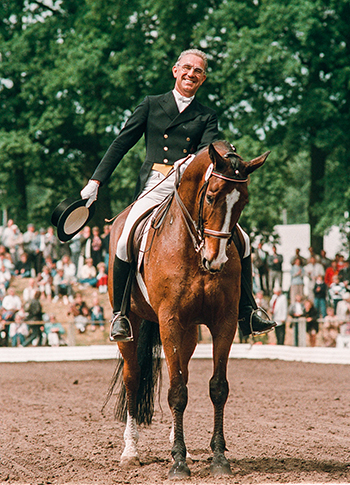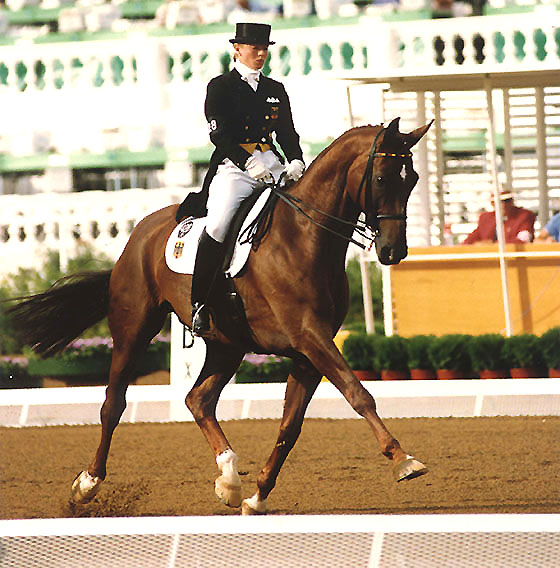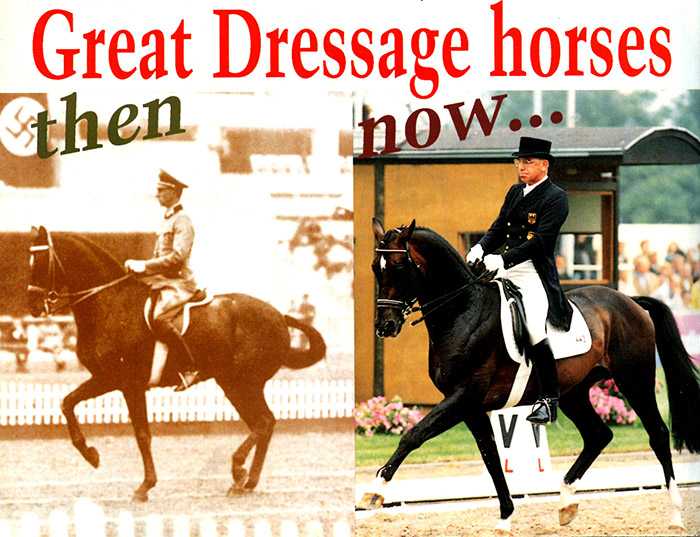
by Christopher Hector
Back in 1995, I sat down with the great Reiner Klimke to look at Gustav Rau’s photos of the German dressage horses of 1936, and have Reiner comment on the differences between then and now…I’ve even forgotten where I found the book, but it was many years ago, and Gustav Rau’s book, Die Reitkunst der Welt a den Olympischen Spielen 1936 remains one of my treasured possessions. Only recently with the help of Dr Google (and a lot of assistance from Thomas Hartwig) I managed to translate Rau’s chapter on the training scale. Again, I remember being amazed at how generous Reiner Klimke was with his time, and how willing to share his knowledge…
The obvious star in the photos is Kronos, who went on to win the individual Gold Medal. Kronos was a Trakehner, born in 1928, he was by Carol and out of Eule. Interestingly, the silver medal winner, Absinth was also by Carol, and out of Estrella, a daughter of Eule by the Arabian stallion, Amur.
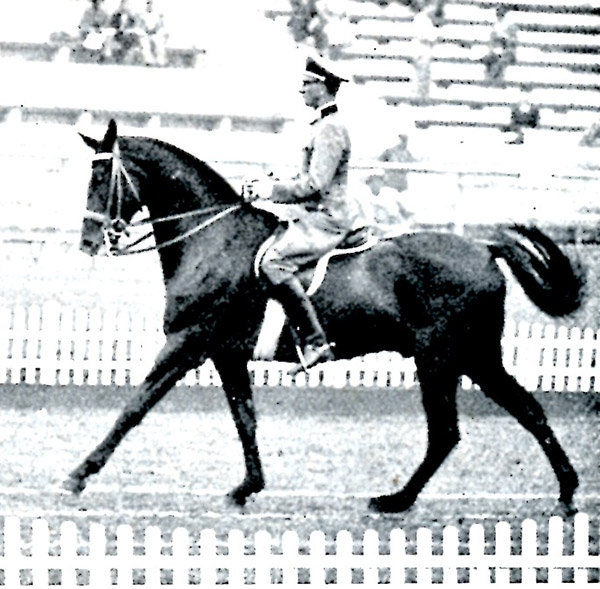
Kronos – Working Canter. In his book, Gustav Rau comments on each of the photos:
Working canter on the diagonal on the left rein. Horse shows too much flexion to the left in the neck.
Dr Klimke comments: “This horse, Kronos, was a most elegant horse, from Trakehner blood. The rider, Mr Heinz Pollay was a judge at the Olympics in Munich in 1972. What an achievement, to be the Olympic winner in 36, then the judge in 1972, the second time we had the Olympics in Germany.”
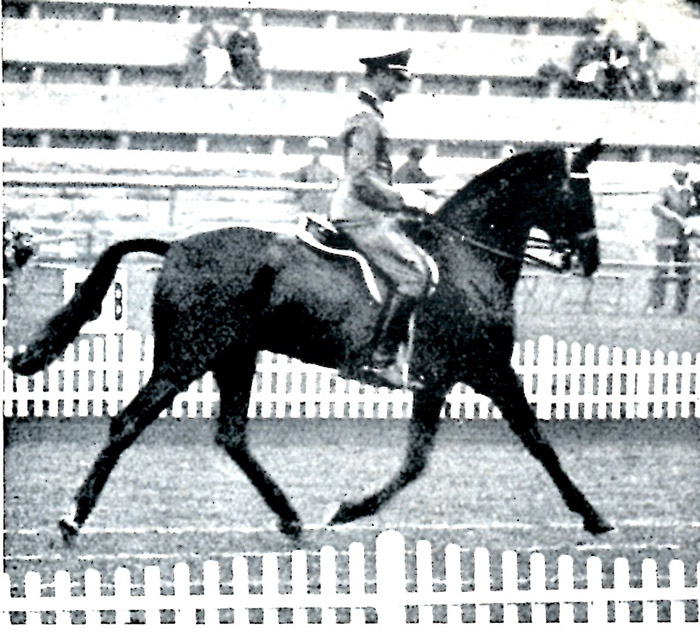
Rau: Extended trot on the diagonal. High degree of energy. Complete equilibrium of the horse. Full harmony between rider and horse.
“I have heard a lot from friends about this horse. My teachers were the brothers, Stecken – Albert, Paul and Fritz, and Fritz was in Berlin when Kronos was trained. Everybody says he was a beautiful horse.”
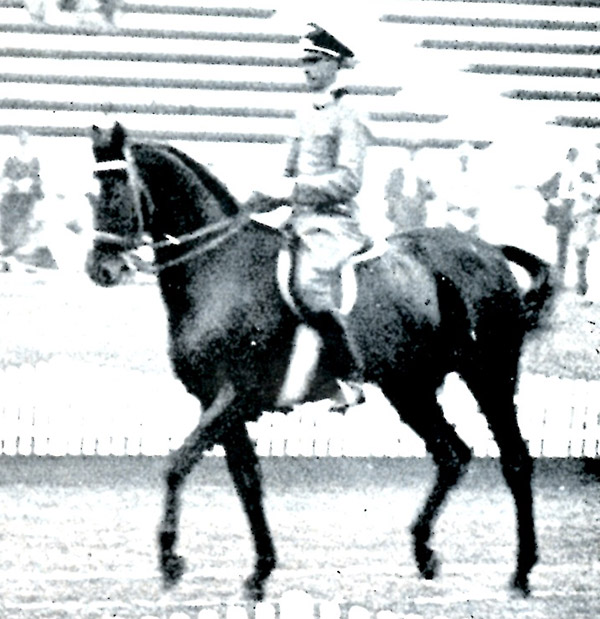
Rau: Half pass zig zag. The horse is moving without any effort in its natural equilibrium, easy like a dancer, in spite of the changes of direction following each other rapidly.
“Looking at the photos is not really fair because the technique of photography was different then. Some of these photos are taken at the wrong moment. You can make from any horse a good photo and a bad photo, even from the winner, you can make a terrible photo even in the test he wins. If you look at this trotting photo, you could believe that the hindquarters are not down, they are up, because this is the moment the horse steps down – if you didn’t take that into account you would say that the horse goes wrong but if you take the next moment, he would be correct. So you must ignore the technique of the photographers, but look instead at the type of horse.
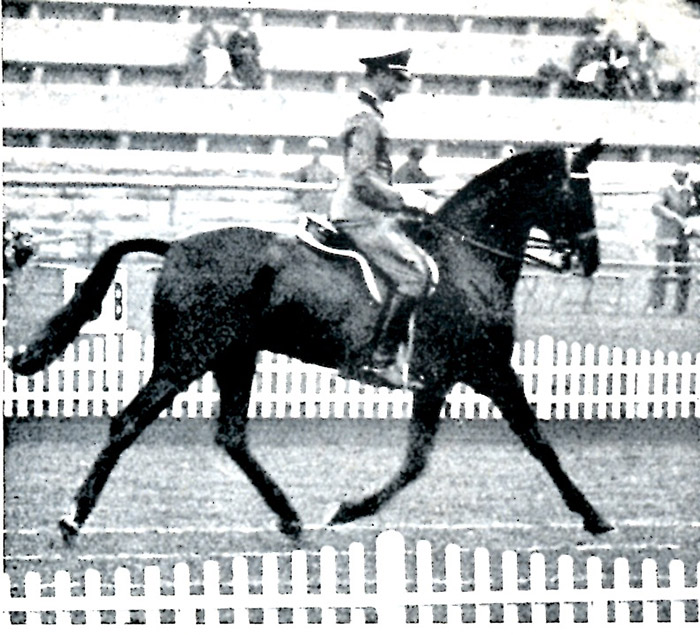
Rau on Kronos: Extended trot on the diagonal. High degree of energy. Complete equilibrium of the horse. Full harmony between rider and horse.
But not all our horses were like Kronos in 1936. If you look for instance at Absinth of Major Freidrich Gerhard. He was an ordinary horse, the sort of ordinary Warmblood horse we used to have after the War, that we used to have for the Cavalry- because the Cavalry horse has another aim, to serve for the soldier, absolute obedience for War.
This philosophy we do not have any more, the horse is not our slave, the horse is our friend. We look for other things – expression, the way he goes, the presence, this is what wins now. The Cavalry School aim was absolute obedience, but this has changed and with it, our breeding.”
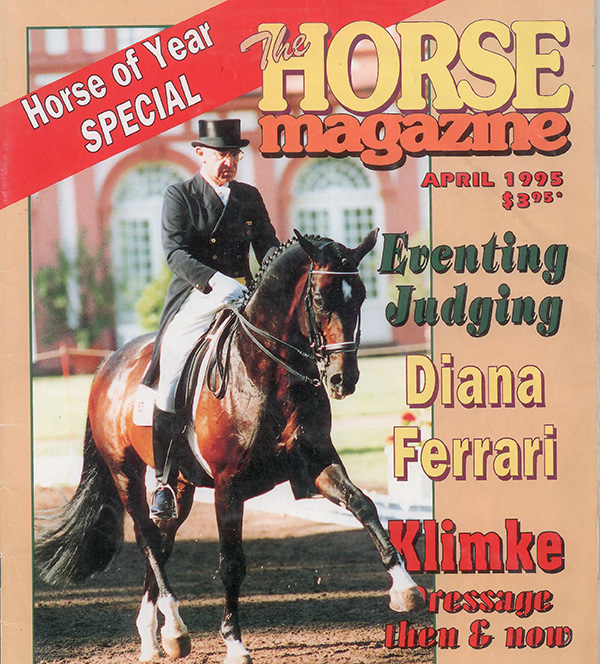
This is the cover of the magazine in which this interview with Dr Klimke appeared, with Biotop at Wiesbaden on the cover. Pic Werner Ernst
“Mr Pollay’s horse, Kronos, he came from East Prussia, and after the War we did not have East Prussia any more, the Russians took all the stallions away. My Biotop’s blood is coming back to Trakehner, he is a Russian Trakehner. But in the Western part of Germany, where I lived was the different type being bred, more like Absinth.”
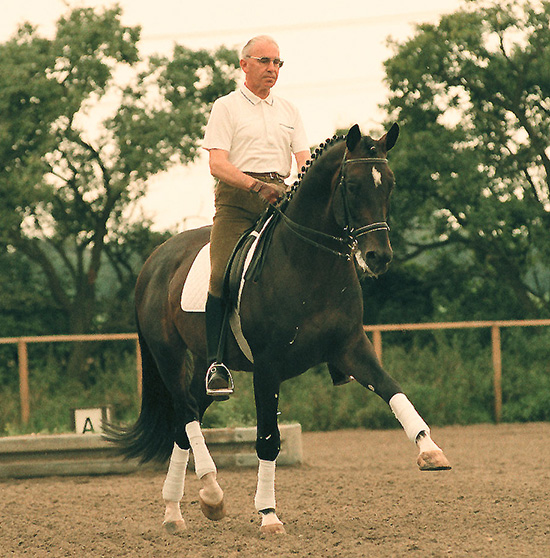
Dr Klimke working at home with Biotop
“When the country was cut after the War by the Wall, we were left with the breeding in the West, which was very famous for its registration, we knew all the bloodlines, which horse was related to which, so we could build up a step by step a very good breeding program. We only needed the horse for sport, because there is no longer an agricultural role for him, so we had to, and we did, change our breed. The only horses we now breed are elegant horses for sport.”
“In my opinion, Kronos is a horse that you could speak of in the same sentence as Rembrandt, or Ahlerich, he is the same really top horse. Tomorrow he would win as he did in 1936 – as long as he went without mistakes.”
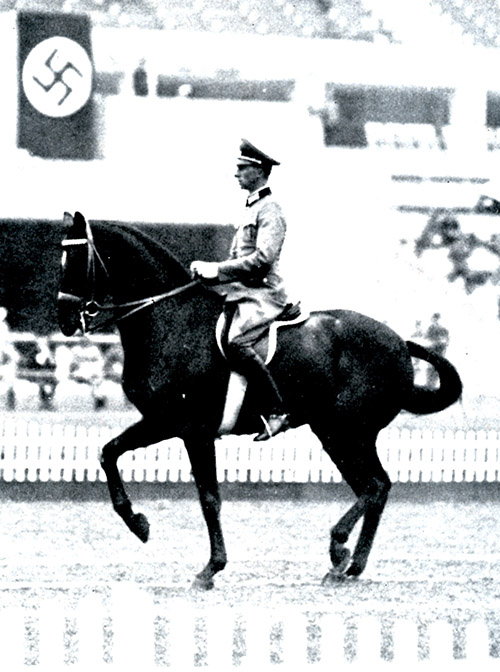
Kronos in piaffe, Rau comments: This performance can be called a perfect piaffe. Kronos shows plenty of suppleness. He trots on the spot. A wonder of equilibrium. He is doing his task on invisible aids, with his rider sitting excellently.
“Looking at the rest of the 1936 team, Absinth was more ‘normal’. He won by a very correct performance. Gimpel (by the Thoroughored, Wandersmann out of Zigeurnerin, a mare of 5/8th Thoroughbred breeding and ridden by Hermann von Oppeln-Bronikowski) he was nineteen years old at the time of the Olympics. He had competed in 1928 in Amsterdam and we younger people then asked, why when Cavalry had everything – horses and riders – did you have a nineteen year old horse in the team?”
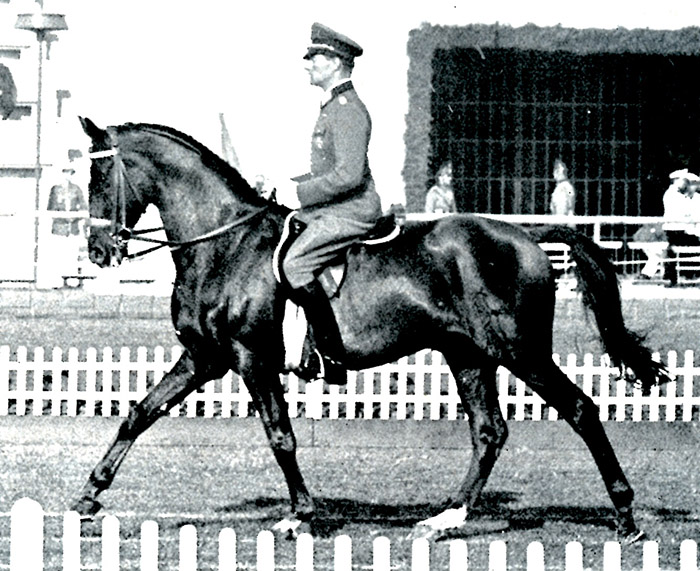
Rau on Rittmeister Bronikowski and Gimpel: Collected canter on the centre line. Highest harmony between horse and rider. Horse in fullest suppleness and ideal equilibrium. Good seat of the rider, ensuring full influence on his horse.
“lt is hard to compare Gimpel with today’s horses… because the riders of today’s horses would be upset, but you can see them now on horses just like him.”
What about the riders – has much changed in their technique since 1936?
“Looking at these photos, the really classical rider Pollay. He has an elegant seat, really nice hands, really nice position, he really supports the horse. Look at them in piaffe, it is very light, the horse carries the neck himself.”
“Mr Gerhard was one of the famous bereiters, the trainers in the Cavalry School. With him it looks a little bit more like hard work. I did not see him ride with my own eyes, but I knew people who worked with him a little.”
“Bronikowski was later a trainer in Canada, he trained Christelot Boylen. He was a little bit more to the light seat – he looks a little bit like a Three Day Event rider. He is sitting a little bit forward, and doesn’t make himself heavy, which I like. When I ride, I always try to not make myself heavy and bring the horse down, but to go with the movement and keep light, but as you can see from this photo from 1936, this is not one of our inventions.”
So what has changed since 1936?
“The riders are younger. When I started, they said you can ride half your lifetime, and then you will start to be a really good Grand Prix rider. Nicole was twenty two when she became the Olympic winner, the youngest winner ever, she was European champion at twenty-one… look at lsabell, Monica, Sven, my son Michael, they are all young. We produced the idea that dressage can be a sport for young people, and that was a revolution, and that has changed our sport. In 1936, the young people had no chance, now the young people dominate our sport, and that is very good for the sport.”
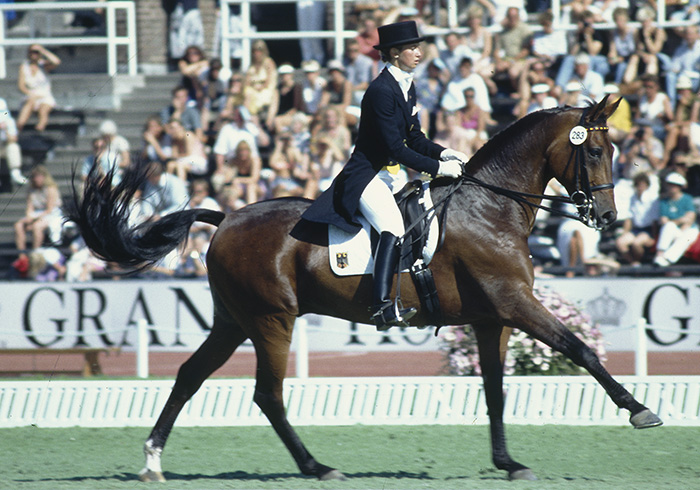
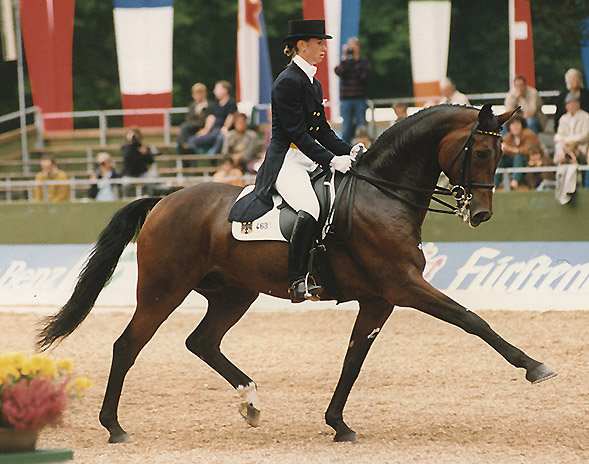
Nicole Uphoff and Rembrandt
Isabell Werth now number one in the world, with Gigolo in 1998
But are they riding as beautifully as Pollay?
“lt is difficult to say, I doubt it a little bit. But it is difficult to compare different eras.”
But what do they lack – subtlety, technique?
“Dressage is also a lot of experience and feeling, and this you can only get by going in competition, and learning, learning, learning, and this process takes some years, even if you are very talented. Forty years ago at the age of eighteen, I won my first Prix St Georges at Berlin Horse Show, maybe it was a good performance, but I did not have the feeling and the experience that I had when I made my first Olympic performance, because time is very important.”
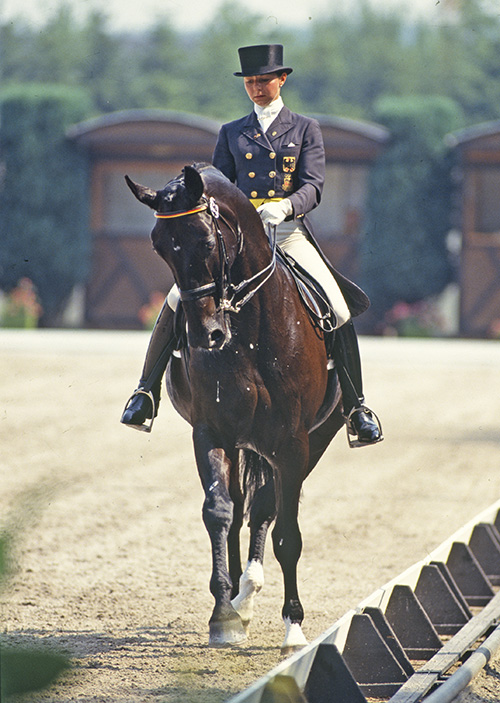
Monica Theodorescu, dressage coach from 2018, here at Aachen with Ganimedes
“Every horse is different, but you learn to compare, what to do in this moment with this particular horse, that takes time – dressage doesn’t go fast, this is the difference between our young riders and our more experienced riders.”
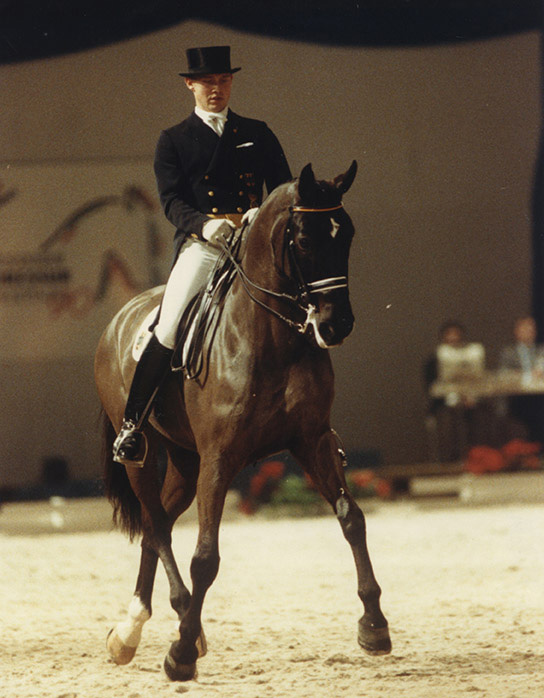
Sven Rothenberger and Andiamo. Sven’s family carries on the family tradition competing at the highest level…
“We made the sport for the younger riders a little lighter than the way we learnt it because we had a lot of good trainers, who provided them with finished trained horses – not Rembrandt of course – but our system for preparing young riders is the best in the world.”
“In every part of the country, Westfalia, Hanover, Holstein, or whatever, they have tryouts for the final competition in Dortmund, and another set of heats for the European Championships – so the young riders have a system of competitions and training which we didn’t have, when I started.”
“Now we have lots of people who have enough money to buy finished, trained horses for their children, as schoolmasters. Sometimes these young people think they can ride – and not all can ride, but the best, they can ride. We make the way for young people much easier than when we started.”
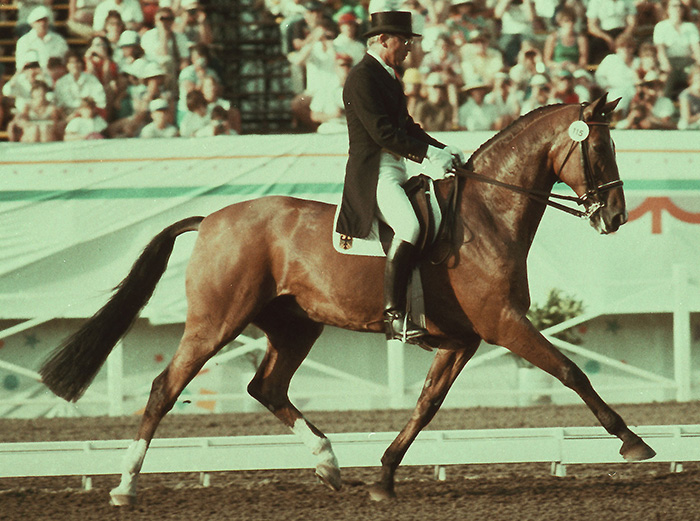
Dr Klimke and his star, Ahlerich
“Now in 1995 we have a lot of better horses than they had in 1936, of course there will always be exceptional horses in any time, but the average horse we have is better, horses that are easier to ride with less power. We have horses that can carry themselves, the self going horse which is proud. In 1936 they had no need for this – they had a need for Cavalry, and from the Cavalry they took out some horses for sport. Now we breed only Rembrandts and Gigolos, if we can – and therefore we have developed our sport.”
“The riding has not become better. lt was very good before us, and we should accept this.”
Where do you see dressage going in the next thirty years?
“It is difficult to say. It will not develop more in our country, we will start to have problems, because we are on the highest point now, and starting to look a little down. We must make new programs now and it will be more difficult than it was before because the number of our top trainers is not more, it is less, there I see a problem. But other countries, for instance Holland, they are coming, they are very much individuals, fine, but when you bring these people together at an international competition, then you don’t know beforehand who will win, and that is good for dressage.”
Breed your own dressage star in Australia this season and choose from a great range of exciting new European sires – go to www.ihb.com.au
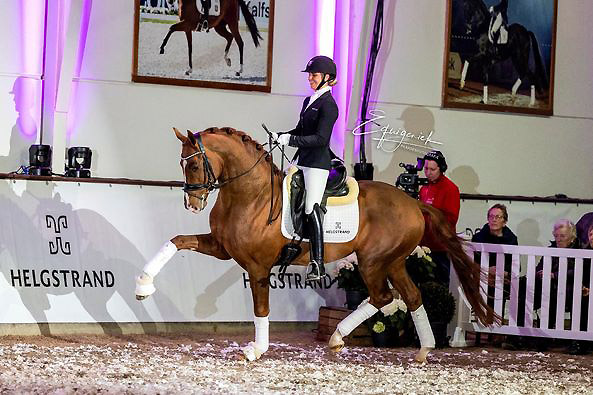
Fifty Fifty

